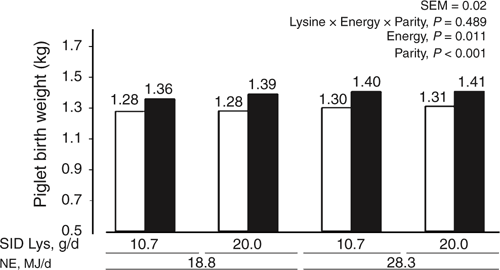Maternal dietary energy rather than lysine intake during late gestation positively influences piglet birth weight
M. A. D. Goncalves A D , K. Gourley B , S. S. Dritz A , M. D. Tokach B , N. M. Bello C , J. M. DeRouchey B , J. C. Woodworth B and R. D. Goodband BA College of Veterinary Medicine, KSU, Manhattan, KS 66506, USA.
B College of Agriculture, KSU, Manhattan, KS 66506, USA.
C College of Arts and Sciences, KSU, Manhattan, KS 66506, USA.
D Corresponding author. Email: marcio@k-state.edu
Animal Production Science 55(12) 1505-1505 https://doi.org/10.1071/ANv55n12Ab120
Published: 11 November 2015
Increasing the feed allowance in late gestation for gilts and sows is known as ‘bump feeding’. However, the effect of bump feeding on piglet birth weight, particularly in herds of high prolificacy (>14.5 total piglets born/sow), is unclear. Further, the relative contributions of dietary amino acids and energy on potential improvements in piglet birth weight remain unclear. Preliminary results (Gonçalves et al. 2015) showed that compared to high-energy intake, low energy during late gestation significantly decreased body weight (BW) gain with a greater magnitude in sows than in gilts. Additionally, there was no difference between bump feeding and the control in the number of total piglets born or in total litter weight. The objective of the current study was to evaluate the effects of lysine (Lys) and energy intake during late gestation on individual piglet birth weight and on subsequent reproductive performance of gilts and sows. It was hypothesised that both maternal dietary Lys and energy in the late gestation period would affect piglet birth weight.
A total of 1105 females (PIC 1050; d 90 of gestation until farrowing) were blocked by parity (P1 or P2+). Females within each parity group were housed in pens, blocked by weight within each pen and individually assigned to dietary treatments consisting of combinations of two standardised ileal digestible lysine (Lys) intakes (10.7 or 20.0 g/day) and two energy intakes (18.8 or 28.3 MJ net energy (NE)/day). Diets were corn-soybean meal-based. Data were analysed using generalised linear mixed models (SAS®; USA) with pen as the experimental unit for parity and the individual female as the experimental unit for dietary treatments.
Individual born alive birth weight was approximately 30 ± 8.2 g heavier (mean ± SEM, P = 0.01; Fig. 1) in high energy intake compared to low energy intake females, regardless of Lys intake. Overall, piglets born from sows were approximately 97 ± 9.5 g (mean ± SEM) heavier (P < 0.001) than those born from gilts. There was no evidence for dietary differences (P > 0.17) on the coefficient of variation for birth weight within a litter, and neither on litter size after cross-fostering (P = 0.46). Pre-weaning mortality was reduced (P = 0.03) by 1.2 percentage points in piglets suckling from high Lys intake females, regardless of energy intake. There was no evidence for differences (P > 0.10) between dietary treatments on wean-to-oestrus interval, percentage of females bred until 7 days after weaning, and subsequent performance (farrowing rate, total born, and born alive). These data support a positive dietary energy intake effect, but no evidence for any Lys intake effect, on piglet birth weight under commercial conditions in a high prolificacy herd. No evidence for any dietary effects on subsequent reproductive performance of either gilts or sows was apparent. Thus, the positive effect of bump feeding on individual piglet birth weight is due to energy rather than lysine intake. While females gained weight regardless of dietary treatment, this suggests 18.8 MJ NE/day could be below their total energy requirement in late gestation.

|
References
Gonçalves MAD, Gourley K, Dritz SS, Tokach MD, Bello NM, Derouchey JM, Woodworth JC, Goodband RD (2015) Journal of Animal Science 93, 64[Abstr]| Crossref | GoogleScholarGoogle Scholar |


